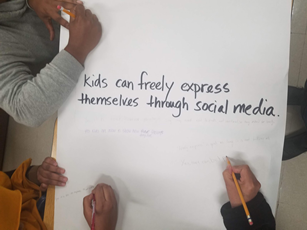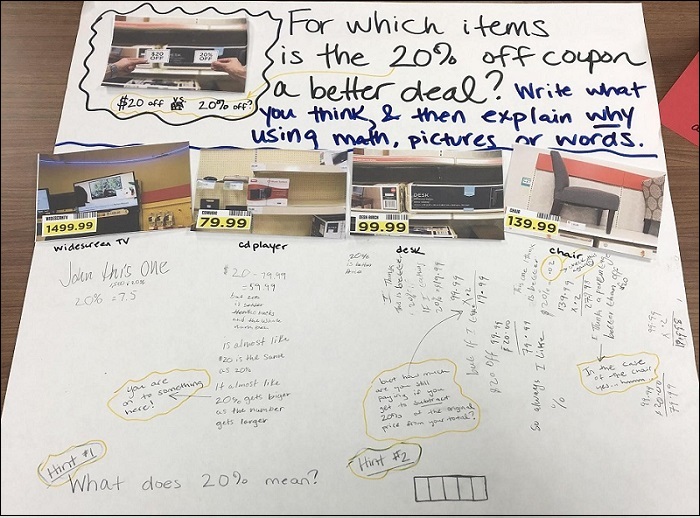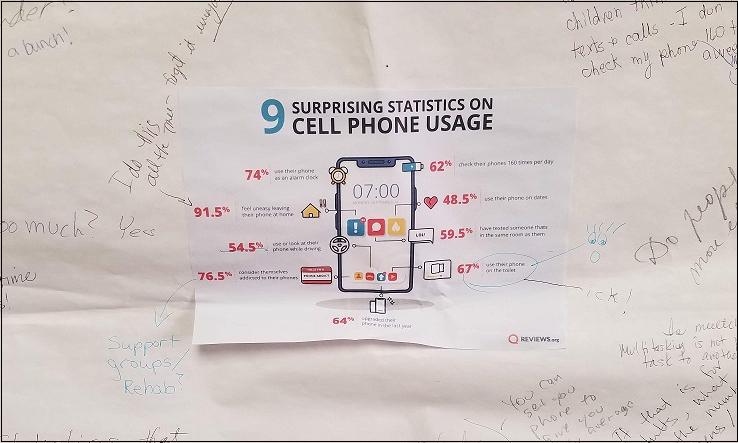- MN ABE Connect
- Archive
- Making Thinking Visible in Math and ELA Instruction: Part 4 – Chalk Talk
 February 17, 2020
February 17, 2020
Making Thinking Visible in Math and ELA Instruction: Part 4 – Chalk Talk
Lindsey Cermak, Numeracy Coordinator Kristine Kelly, Literacy & ELA CoordinatorWelcome to our final installment of our “Making Thinking Visible” series, where we are looking at some key strategies for making our students’ invisible thinking moves VISIBLE. In past newsletters (Part 1, Part 2, and Part 3), we have shared articles on making thinking in the classroom visible. As a reminder from the first article of the series, we need to empower our learners to be able to make their thinking visible more efficiently. It is up to us to employ strategies in the classroom that model how to make thinking visible and create spaces for learners to share their ideas in new ways. To draw these types of thinking out of students, we have been describing key strategies in our newsletter articles. All the strategies presented are appropriate for the math and/or ELA classroom.
Our final strategy is Chalk Talk, a “dialogue” that happens completely on paper with no talking and no actual chalk! Chalk talks are a great way to “hear” everyone’s ideas. Students silently reflect on what they know and then share their thinking and wondering on paper while connecting to the thoughts of their classmates.
- Use Chalk Talk to activate prior knowledge/build motivation
- Use Chalk Talk at the end of a lesson for reflection
- Use questions, statements, significant quotes, key ideas, visuals, etc. for prompts
- Use with controversial topics to provide a safe environment to respond
Strategy 3: Chalk Talk
Begin by putting prompts (questions, statements, significant quotes, key ideas, visuals, scenarios, math problems) on sheets of flipchart paper (one per sheet), and place the sheets in different parts of the room. Students then start at one sheet of flipchart paper and write their thoughts in response to the statement on the page. Once done, students rotate to the next sheet of paper and engage with the new statement and with comments/questions left by the previous group of students. Students should get a short time to think about each prompt followed by two or three minutes of writing. If time permits, students can rotate through the prompts again to answer questions or consider comments of other students. This activity is about expressing ideas, so tell students not to worry about grammar, usage or mechanics errors!
Students can do any of the following on the sheets of paper:
- Write down what they are thinking or wondering about
- Circle interesting ideas
- Write a question or answer a question
- Add a comment to other people’s comments
- Draw a line connecting their comment or question to a similar one and write a connection
 In Kristine’s Academic Literacy class, she used Chalk Talk to build interest in a unit focused on kids and social media. The following statements were posted on flipchart papers around the room:
In Kristine’s Academic Literacy class, she used Chalk Talk to build interest in a unit focused on kids and social media. The following statements were posted on flipchart papers around the room:
- Kids can freely express themselves through social media.
- Kids are not mature enough to be on social media alone.
- Kids should have a place online that is private from parents.
- Kids can learn about what’s going on in the world through social media.
- Kids’ independence online depends on their age.
In Lindsey’s class, she had her flipchart paper available for several days for students to add to, as she has more turbulent attendance:

Other ideas for a math classroom are to put a different problem on each sheet of flipchart paper and ask learners to first solve a problem and then rotate to offer feedback to their classmates’ solutions to the other problems. Another idea is to put a different scenario (without a question) on a sheet of paper and see what questions students generate to match that scenario. Consider turning a Notice and Wonder prompt (the same prompt on each sheet of paper) into a Chalk Talk and have learners rotate to comment on their classmates’ observations and ideas.
So many different prompts could be used, such as this one used during a session at the recent Language & Literacy Institute:

A post-activity could include:
- Discussing what was surprising or new
- Looking for trends, common reactions or issues
- Correcting any misconceptions
- Considering questions that were left unanswered
Chalk Talk is an ideal activity to facilitate participation from ALL students, especially students who don’t feel comfortable speaking up in class or sharing opinions. Also, consider how Chalk Talk could be done in a Google Doc or on an app like Padlet!
For more information about ways to make student thinking visible, check out the archived MN CCRS TA webinars from October 31, 2019: Making Thinking Visible and January 31, 2020: Get Them Talking – Promoting Classroom Conversation. They are archived on our MN ABE Professional Development YouTube channel (http://tinyurl.com/mnabepd).
Newsletter Signup
Get MN ABE Connect—the official source for ABE events, activities, and resources!
Sign UpArticle Categories
- ABE Foundations/Staff Onboarding
- ACES/Transitions
- Adult Career Pathways
- Assessment
- CCR Standards
- Citizenship
- COVID-19
- Cultural Competency
- Digital Literacy/Northstar
- Disabilities
- Distance Learning/Education
- ELA
- Equity/Inclusion
- ESL
- HSE/Adult Diploma
- Listening
- Math/Numeracy
- Mental Health
- Minnesota ABE
- One-Room Schoolhouse/Multilevel
- Professional Development
- Program Management
- Reading
- Remote Instruction
- Science
- Social Studies
- Speaking/Conversation
- Support Services
- Teaching Strategies
- Technology
- Uncategorized
- Volunteers/Tutors
- Writing